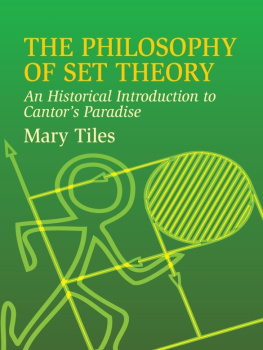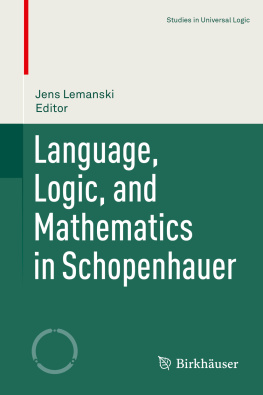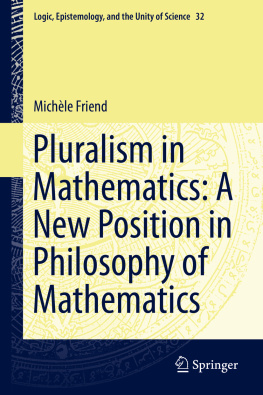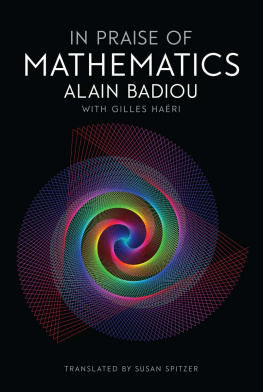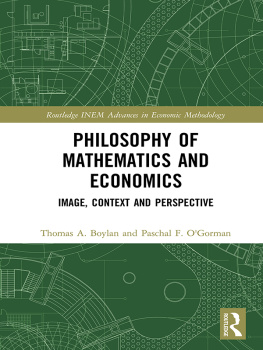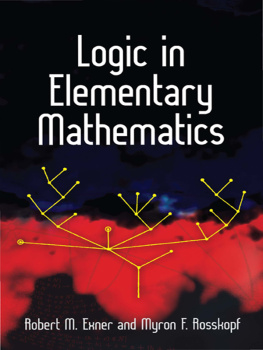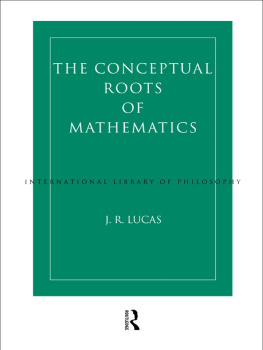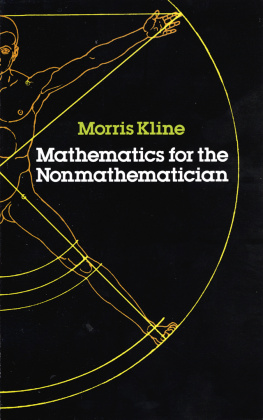Mary Tiles - Mathematics and the Image of Reason
Here you can read online Mary Tiles - Mathematics and the Image of Reason full text of the book (entire story) in english for free. Download pdf and epub, get meaning, cover and reviews about this ebook. year: 1991, publisher: Routledge, genre: Religion. Description of the work, (preface) as well as reviews are available. Best literature library LitArk.com created for fans of good reading and offers a wide selection of genres:
Romance novel
Science fiction
Adventure
Detective
Science
History
Home and family
Prose
Art
Politics
Computer
Non-fiction
Religion
Business
Children
Humor
Choose a favorite category and find really read worthwhile books. Enjoy immersion in the world of imagination, feel the emotions of the characters or learn something new for yourself, make an fascinating discovery.
- Book:Mathematics and the Image of Reason
- Author:
- Publisher:Routledge
- Genre:
- Year:1991
- Rating:5 / 5
- Favourites:Add to favourites
- Your mark:
- 100
- 1
- 2
- 3
- 4
- 5
Mathematics and the Image of Reason: summary, description and annotation
We offer to read an annotation, description, summary or preface (depends on what the author of the book "Mathematics and the Image of Reason" wrote himself). If you haven't found the necessary information about the book — write in the comments, we will try to find it.
Mary Tiles: author's other books
Who wrote Mathematics and the Image of Reason? Find out the surname, the name of the author of the book and a list of all author's works by series.
Mathematics and the Image of Reason — read online for free the complete book (whole text) full work
Below is the text of the book, divided by pages. System saving the place of the last page read, allows you to conveniently read the book "Mathematics and the Image of Reason" online for free, without having to search again every time where you left off. Put a bookmark, and you can go to the page where you finished reading at any time.
Font size:
Interval:
Bookmark:
General Editor
W. H. Newton-Smith
THE RATIONAL AND THE SOCIAL
James Robert Brown
THE NATURE OF DISEASE
Lawrie Reznek
THE PHILOSOPHICAL DEFENCE OF PSYCHIATRY
Lawrie Reznek
INFERENCE TO THE BEST EXPLANATION
Peter Lipton
forthcoming
TIME, SPACE AND PHILOSOPHY
Christopher Ray
Mary Tiles

First published 1991
by Routledge
11 New Fetter Lane, London EC4P 4EE
Simultaneously published in the USA and Canada
by Routledge
a division of Routledge, Chapman and Hall, Inc.
29 West 35th Street, New York, NY 10001
Mary Tiles 1991
Typeset in 10/12 Times by
J&L Composition Ltd, Filey, North Yorkshire
Printed and bound in Great Britain by
TJ Press (Padstow) Ltd, Padstow, Cornwall
All rights reserved. No part of this book may be reprinted or reproduced or utilized in any form or by any electronic, mechanical, or other means, now known or hereafter invented, including photocopying and recording, or in any information storage or retrieval system, without permission in writing from the publishers.
British Library Cataloguing in Publication Data
Tiles, Mary
Mathematics and the image of reason.
1. Mathematics. Philosophical perspectives, history
I. Title II. Series
510.1
Library of Congress Cataloging in Publication Data
Tiles, Mary.
Mathematics and the image of reason / Mary Tiles.
p. cm . (Philosophical issues in science)
Includes bibliographical references (p. )
1. MathematicsPhilosophy. 2. Frege, Gottlob, 18481925.
3. Russell, Bertrand, 18721970. 4. Hilbert, David, 18621943.
I. Title. II. Series .
QA8.4.T538 1991
510.1dc20 908971
ISBN 0415033187
TO ALAN
For, Things Mathematical, being (in a manner) middle between the supernatural and the natural, are not so absolute and excellent as things supernatural, nor yet so base and gross as things natural, but are things immaterial, and nevertheless, by things material able somewhat to be signified. And though their particular images, by Art, are aggregable and divisible, yet the general Forms not withstanding, are constant, unchangeable, untransformable, and incorruptible. Neither of sense can they, at any time, be perceived or judged. Nor yet, for all that, in the royal mind of man first conceived. But surmounting the imperfection of conjecture, weening and opinion, and coming short of high intellectual conception, are the Mercurial fruit of Dialectical discourse, in perfect imagination subsisting. A marvellous neutrality have these things Mathematical, and also a strange participation between things supernatural, immortal, simple and indivisible, and things natural, mortal, sensible, compounded and divisible. Probability and sensible proof may well serve in things natural, and is commendable. In mathematical reasonings, a probable argument is nothing regarded, nor yet the testimony of the sense any whit credited, but only a perfect demonstration of truths, certain, necessary and invincible, universally and necessarily concluded is allowed sufficient for an argument exactly and purely mathematical.
John Dee (1570)
I wish to thank Bill Newton-Smith for encouraging and facilitating the production of this book, Ray Mines for discussion, for bringing relevant material to my attention and for reassurance that there are mathematicians willing to talk about the philosophy of mathematics. Thanks also to Jim for having lived with the whole writing process.
Post-modernists proclaim the failure of the projects of the Enlightenment the death of philosophy, epistemology, morality, imagination and reason. Nietzsche announced the death of God and with him died all hope of founding either a secular morality or a secular epistemology. If God is dead, then so too is that of God in every man, that natural light of reason by which the Good and the True stand revealed. Even mathematics suffers a loss of certainty (Kline 1980). Yet in the very culture within which this loss occurs there has a arisen a new faith the cult of information technology, of the computer, of scientific facts and figures. But how can numerical representation and computation be worshipped in this way after the death of the mathematician-god, architect of the universe, and after the discrediting of the myth of a supersensible mathematical reality? Because, as in all supplanting of one faith by another, there is a supporting mythology of conquering and vanquished heroes. Transcendent reason, on which the Enlightenment pinned its hopes, has been imprisoned in formal, computational chains and it is the celebration of this victory which forms a necessary, legitimating complement to post-modernist claims. Enlightenment is impossible because reason has been rendered practically and theoretically impotent; it is confined to symbol manipulation, infallibly tracing paths through symbol structures, but incapable of showing a way out of these man-made information-labyrinths, or even of determining the transition from one such labyrinth to another.
A striking feature of mathematics is that it has two distinct faces its number-crunching, calculatory face, revealed in applications, and its almost number- and calculation-free face, revealed in the pure mathematicians study of abstract structures. Somehow these are related; somehow the non-wordly, abstract study where theorems are proved with an exactness and certitude unparalleled in other branches of knowledge yields powerful methods and techniques for dealing with the physical world. Reason delivers, with apparent certainty, knowledge of an abstract, non-empirical realm, knowledge which is nonetheless of immense practical utility in the empirical world. Is it then any wonder that this should be treated as the paradigmatic manifestation of the power of reason? But at the same time this very power presents a puzzle and a philosophical challenge how is it possible?
The mystery can be temporarily dispelled by the postulation of a mathematician-god, creator and architect of both the universe and the mind of man, or simply of the minds of all men, determining the forms of their experience and of their thought and ensuring the possibility of a concordance between the two. The pure mathematicians mathematics, which has led to Pythagoreanism, Platonism and number mysticism, yields an image of a pure contemplative reason with the power to transcend the empirical world, to glimpse the Reality beyond, to participate in the Creators ideas, learning to read the language of His universe and/or the super-sensible realm of Forms. This solution does, however, leave transcendent, mathematical reason hostage to the fate of God or of our ability to participate in His knowledge. If God is dead, or if we may not presume to share His knowledge, then the transcending power of mathematical reason also vanishes, stripped of its credentials as a source of knowledge. Mathematics is then reduced to its applications; it is a source only of convenient representational and calculatory devices. The number crunching involved in applied mathematics, which predominates in technological thinking, spawns a calculatory image of reason.
Perhaps the power of reason was mischaracterized and the philosophical problem misposed. The failure of one solution to the puzzle of the two faces of mathematics does not necessarily entail the failure of all solutions. The way in which the puzzle is made precise, the exact formulation of the philosophical problem posed, is as open to question as its metaphysical solution. It remains the case, however, that any account of mathematics must address itself to the characterization and the relation of the two aspects of mathematics, resisting either a reduction to a single aspect or a mystificatory unification via a metaphysical postulation.
Font size:
Interval:
Bookmark:
Similar books «Mathematics and the Image of Reason»
Look at similar books to Mathematics and the Image of Reason. We have selected literature similar in name and meaning in the hope of providing readers with more options to find new, interesting, not yet read works.
Discussion, reviews of the book Mathematics and the Image of Reason and just readers' own opinions. Leave your comments, write what you think about the work, its meaning or the main characters. Specify what exactly you liked and what you didn't like, and why you think so.


